Frequency inverter - definition, setup, and types
17.01.2022
CONTENTS:
- Modern frequency converters
- Classification of frequency converters
- Design of a typical frequency converter
- Economic benefit of frequency converters
- How to connect the frequency converter?
- The functioning principle of frequency converters
- The power of a frequency converter
- Protection functions
- Installation and mounting of frequency converter
Electric DC drives are very simple in terms of organization of the motor speed control system, but the electric motor itself is the weak link in the system because it is quite expensive and at the same time not particularly reliable. In addition, the scope of application of these motors is limited because of excessive sparking brushes and, consequently, increased electrical erosion and wear of the collector, which generally does not allow the use of DC motors in dusty conditions and environments with the danger of explosion.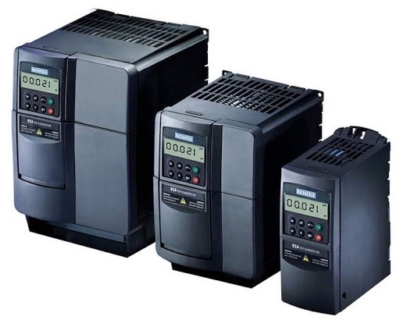
An alternative to inverter meaning drives is the combined use of AC induction motors with frequency converters. Asynchronous motors are widely used because of their very simple design and reliability, they have the same power as DC motors while being smaller and lighter. The main disadvantage of them is the complexity of the organization of the motor speed control system by traditional methods for DC motors.
The theoretical basis for the development of the first frequency converters, which could already be a solution to the issue of speed control, was laid in the 30s of the twentieth century. Lack of microprocessors and transistors did not allow to put theory into practice, but with the advent of transistor circuits and control microprocessors in Japan, the USA, and Europe at about the same time variants of frequency converters were developed.
Modern frequency converters
The market of electrical equipment is represented by frequency converters for a wide range of applications. The devices can be low power as well as high-voltage units. Modern devices provide continuous process control in systems with induction and synchronous motors.
Frequency control devices have found wide application in almost all branches of industry and transport. The main share of all-electric power produced in the world is used to run electric motors, and the function of controlling their operation is entrusted to frequency converters.
Modern frequency converters are used as controls in the following systems and equipment:
- conveyor mechanisms;
- lifting equipment (cranes, elevators);
- pumps and water treatment systems;
- industrial machines;
- fans.
The right choice of the device according to predefined criteria will ensure continuous and stable operation of the drive and reduce energy costs.
Classification of frequency converters
A variable frequency drive explained that converts an alternating voltage of one frequency at the input, in a variable voltage changing according to a certain law, but already a different frequency at the output is called a frequency converter. They are of two types:
- Direct.
- Two-branch.
The direct type is a reversible thyristor converter. Its main advantage is that it is connected directly to the mains without any additional devices.
Two-link - it is a transistor or thyristor converter. But their main difference from direct converters is that for the correct and safe operation of the frequency inverter a DC voltage link is required. Accordingly, a rectifier is required to connect them to general industrial networks. As a rule, they are made as complete units (inverter and rectifier are delivered together and work from one control system).
Design of a typical frequency converter
The main task of the frequency converter is to change the parameters of electric current, this is done using transistor rectification of current and converting it to the required preset values. A typical frequency converter consists of three parts: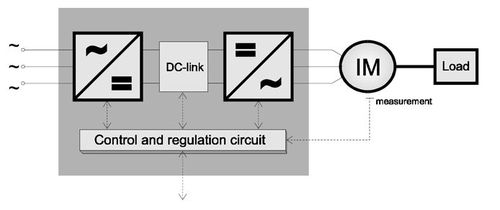
- DC link. It consists of a rectifier and filtering devices. The DC link receives the input signal and redirects it to the inverter.
- Pulse inverter. A three-phase power inverter usually has six switching transistors and converts the current to specified frequencies and amplitudes and then feeds it to the stator. The inverter can consist of a thyristor circuit.
- Microprocessor control system. Controls the inverter's conversion and protection systems.
The clear sinusoidal output signal is the result of IGBT transistors as inverter keys, which operate at a higher switching frequency than the obsolete thyristors.
Economic benefit of frequency converters
When starting a motor without frequency converters, its starting currents exceed the rated currents by several times, which leads to rapid wear and tear and the service life of the unit. Repair of imported motors with high power can cost a lot of money, and in most cases to a complete replacement of the frequency converter motor. It is economically advantageous to install a frequency converter.
There are several other advantages, which will be listed below:
- power saving (up to 70%)
- the longer service life of mechanical and electrical parts
- reduction of repair costs
- cuts the installation of unnecessary equipment
How to connect the frequency converter?
To connect the frequency converter is not difficult, each device comes with a guide for installation and programming. Any specialist with experience in working with electrical equipment can do it without difficulty. Typically, the frequency converter is installed directly after the circuit breaker, which serves to protect the converter, as well as for power outage in case of repair or replacement of the converter.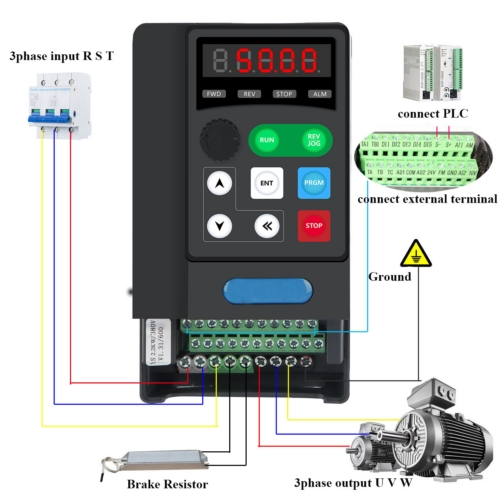
The functioning principle of frequency converters
The inverter function is based on the dependence of rotational speed and torque on the shaft of an alternating current motor on the frequency of supply voltage. Frequency controllers change the frequency of the voltage supplied to the electric motor, thereby regulating the rotor speed and torque.
Frequency conversion can be done in several ways. A frequency conversion circuit with a direct electrical connection to the mains is a thyristor-controlled rectifier. The control unit generates signals that alternately open semiconductor devices that supply voltage of a given frequency to the windings of the electric machine.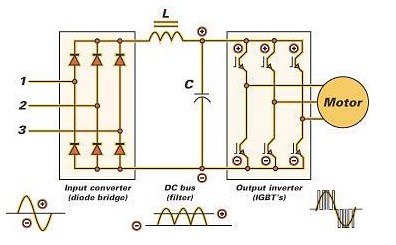
Such a scheme is characterized by high efficiency, provides stable operation of the motor at low rotor speeds, transfer of the generated electricity when braking the motor into the network. However, such disadvantages as the inability to change the frequency upwards, the presence in the output voltage of the constant component, and subharmonics, causing overheating of the windings and the appearance of electromagnetic interference, limit the scope of application of frequency converters with direct coupling.
Most modern frequency converters are based on double-conversion schemes. This technical solution has the following advantages:
- The ability to change the frequency both upward and downward.
- Pure sinusoidal output voltage.
- No higher harmonics.
- Smooth, high-precision frequency control of the motor's supply voltage.
Such a frequency converter consists of three blocks:
- Diode or thyristor rectifier with capacitive, inductive, or combined filters. This unit rectifies the mains voltage and smoothes it.
- Inverting unit. This element converts the DC voltage back to AC voltage. The inductive element at the output filters out the DC component as well as high-frequency inverter noise, the presence of which negatively affects the operation of the electric motor.\
- Microprocessor-based control circuit. Its main function is to set the frequency of the output voltage and current. The frequency of the current at the inverter output is determined by the width or duration of the control pulses from the control circuit (latitude or frequency pulse modulation). The processor also communicates with remote control points, automatically controls the mechanical and electrical frequency converter characteristics of the machine connected to it, and performs other functions.
Thus, in frequency control, the supply voltage is first converted into a direct voltage and then inverted into an alternating voltage of the required frequency.
The power of a frequency converter
Power is one of the most important parameters of electric drive. When selecting a frequency converter, first of all, it is necessary to determine its load capacity. By the available rated power of the motor, a frequency converter is selected, designed for the same power.
And this choice will be correctly provided that the load on the shaft will not change dynamically, the current will not significantly exceed the nominal set value, both for this motor and the frequency converter. Therefore, it would be more correct to select the maximum value of current consumed by the motor from the FC, taking into account the overload capacity of the latter.
Usually, the overload capacity is given as a percentage of the rated current together with the maximum allowable time of this overload before the direct protection is activated. Therefore, to make the right choice, you need to know the nature of the overloads on your machine, in particular: what is the level of overload, how long they last, and how often they occur.
Protection functions
In addition to the control functions, an electronic frequency changer is usually entrusted with protection functions. Typically, the basic set is:
- current limitation during startup, continuous operation, shutdown, and short-circuit;
- overvoltage and undervoltage protection;
- motor temperature control;
- heatsink overheat protection;
- IGBT output protection.
Installation and mounting of frequency converter
An important point is the choice of the proposed location of the frequency converter, and hence the conditions of its operation: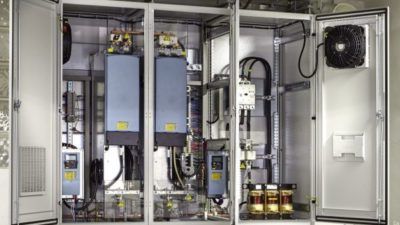
- current limitation at start-up, during continuous operation, at standstill, and short-circuit,
- operating temperature range,
- humidity,
- altitude,
- vibrations,
- degree of protection (IP).
In some cases, compactness is the decisive factor at the stage of choice. What are the dimensions of the drive to be installed and how will it be installed? Can the heat sinks of the power part of the PD be moved to the rear to provide sufficient ventilation in a smaller cabinet?
Information about environmental conditions is an integral part of the specifications when selecting a frequency converter, and failure to comply with them during installation can lead to failure. Many questions arise during the installation process, but these are some of the first to be encountered.
Full product range of Lenze Frequency Inverters you can see in our catalog. Get A Quote Today!